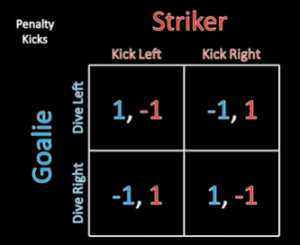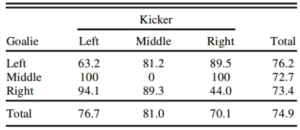Introduction
As we all know, the World Cup started a few days ago. Many of us are supporting either our home countries, or have some sort of allegiance to one of the countries competing in the World Cup (Go Team Canada!). Soccer is a game that relies heavily on the skill of 11 players. If a team of 11 players is more skilled with the ball and as a team than the opposing team, often times they’ll find themselves coming out with a win. But the real intensity starts in the knockout stage of the world cup. In this stage, there can be no draws. If teams find themselves tied at then of 90 minutes plus 30 minutes of extra time, it is time for penalty kicks. Now, instead of it being 11 versus 11, the game comes down to one player versus a goalkeeper. In other words, it is now a one versus one. Can game theory be applied during an intense penalty shootout to give your country the edge?
Game Theory in Penalty Kicks
For those who don’t know, I will begin by explaining how penalty kicks work. It involves two players, a goalkeeper from team A and any player form team B. The goalkeeper must guess where the player will shoot and must stop the ball from going in the net by diving in that direction. The shooting player must shoot the ball in the direction the goalkeeper is not diving in, to score the goal. The simple solution to this is simple, in a payoff matrix the goalie wants to match, while the shooter wants to mismatch. This is shown in the payoff matrix below:

However, in reality it is not so simple because for example, if the shooter shoots left a 100% of the time, the goalkeeper knows to dive left. This then results in the striker’s shooting becoming less effective. Therefore, the strategy outlined in the picture above is the optimal strategy since no party can be exploited. So to not be exploited, the shooter must randomize his shots, and more importantly, you have to take into account your opponents strategic constraints. However, in reality, it is not so simple because shooting right does not always mean that the shooter will score. Additionally, there is a third strategy, shooting down the middle, which is a viable option since that will result in a goal if the goalie dives either to the right or to the left. So in reality, economists find the following chart more helpful:

In this figure, the totals are the most important part. They basically tell us that no matter where the goalkeeper dives, their chance of giving up a goal is always close to 75%. So no matter where they dive, they are picking the optimal strategy since the difference in the percentages is nearly insignificant.
Conclusion
In reality there are even more layers to penalty kicks. Right footed players could be more likely to shoot to the right, or even to the left. Every player will ultimately have a side they are more accurate in shooting, which will help the goalkeeper make their decision on where to dive. Moreover, a goalkeeper knowing that a player is stronger shooting to the right side may make the player shoot to the left side. So, relying on a player’s weakness comes into play as well if either the shooter or a goalkeeper want an edge in scoring. If every shooters penalties are analyzed before a match, the goalkeeper may be more likely to save their penalties. Ultimately, all of these decisions and outcomes can be analyzed using game theory and may end up giving a team an edge over their opponents.
Sources
williamspaniel.com/2014/06/12/the-game-theory-of-soccer-penalty-kicks/
One reply on “Can Game Theory Help your Country Win the World Cup?”
Its amazing to see how game theory can relate to one of the biggest sports around the world and the biggest tournament around the world. Thanks for posting the video as well, its great to visually see and gain a better understanding regarding the topic. Never knew that game theory would have anything to do with penalty kicks but after reading your blog I must say that it makes sense and helps me learn more about the thinking that the players have during the most intense shot in the game.